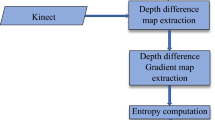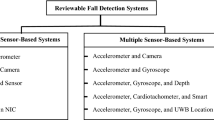Abstract
A fall event is a serious issue for the elderly because it may cause critical aftereffects. To reduce the risk of these aftereffects, early detection of the fall event is essential. However, it is difficult for caregivers to detect fall events early themselves, because they are required to constantly monitor the elderly to confirm their safety. Therefore, an automatic monitoring system which could detect fall events early is helpful in the healthcare field. We have proposed a fall event detection system utilizing a microwave Doppler sensor. The frequency feature is calculated, and compared with known fall or non-fall event data. However, for real-time detection, the number of template datasets must be as low as possible while maintaining high performance of the classification. In this paper, we attempt to identify the relationship between the number of template datasets and the performance of the proposed system.







Similar content being viewed by others
References
United Nations, Department of Economic and Social Affairs, Population Division (2015) World population ageing 2015 (ST/ESA/SER.A/390). http://www.un.org/en/development/desa/population/publications/pdf/ageing/WPA2015_Highlights.pdf. Accessed 16 Nov 2017
Fleming J, Brayne C (2008) Inability to get up after falling, subsequent time on floor, and summoning help: prospective cohort study in people over 90. BMJ 337:1279–1282
Doukas CN, Maglogiannis I (2011) Emergency fall incidents detection in assisted living environments utilizing motion, sound, and visual perceptual components. IEEE Trans Inf Technol Biomed 15(2):277–289
Auvinet E, Multon F, Saint-Arnaud A, Rousseau J, Meunier J (2011) Fall detection with multiple cameras: an occlusion-resistant method based on 3-D silhouette vertical distribution. IEEE Trans Inf Technol Biomed 15(2):290–300
Bianchi F, Redmond SJ, Narayanan MR, Cerutti S, Lovell NH (2010) Barometric pressure and triaxial accelerometry-based falls event detection. IEEE Trans Neural Syst Rehabil Eng 18(6):619–627
Jian H, Chen H (2015) A portable fall detection and alerting system based on k-NN algorithm and remote medicine. China Commun 12(4):23–31
Cheng J, Chen X, Shen M (2013) A framework for daily activity monitoring and fall detection based on surface electromyography and accelerometer signals. IEEE J Biomed Health Inf 17(1):38–45
Liu J, Lockhart TE (2014) Development and evaluation of a prior-to-impact fall event detection algorithm. IEEE Trans Biomed Eng 61(7):2135–2140
Tong L, Song Q, Ge Y, Liu M (2013) HMM-based human fall detection and prediction method using tri-axial accelerometer. IEEE Sens J 13(5):1849–1856
Aziz O, Robinovitch SN (2011) An analysis of the accuracy of wearable sensors for classifying the causes of falls in humans. IEEE Trans Neural Syst Rehabil Eng 19(6):670–676
Shany T, Redmond SJ, Narayanan MR, Lovell NH (2012) Sensors-based wearable systems for monitoring of human movement and falls. IEEE Sens J 12(3):658–670
Cheng WC, Jhan DM (2013) Triaxial accelerometer-based fall detection method using a self-constructing Cascade-AdaBoost-SVM classifier. IEEE J Biomed Health Inf 17(2):411–419
Lee JK, Robinovitch SN, Park EJ (2015) Inertial sensing-based pre-impact detection of falls involving near-fall scenarios. IEEE Trans Neural Syst Rehabil Eng 23(2):258–266
Ozcan K, Mahabalagiri AK, Casares M, Velipasalar S (2013) Automatic fall detection and activity classification by a wearable embedded smart camera. IEEE J Emerg Sel Top Circuits Syst 3(2):125–136
Kau LJ, Chen CS (2015) A smart phone-based pocket fall accident detection, positioning, and rescue system. IEEE J Biomed Health Inf 19(1):44–56
Cheffena M (2016) Fall detection using smartphone audio features. IEEE J Biomed Health Inf 20(4):1073–1080
Yu M, Rhuma A, Naqvi SM, Wang L, Chambers J (2012) A posture recognition-based fall detection system for monitoring an elderly person in a smart home environment. IEEE Trans Inf Technol Biomed 16(6):1274–1286
Bai YW, Wu SC, Tsai CL (2012) Design and implementation of a fall monitor system by using a 3-axis accelerometer in a smart phone. IEEE Trans Consum Electron 58(4):1269–1275
Mirmahboub B, Samavi S, Karimi N, Shirani S (2013) Automatic monocular system for human fall detection based on variations in silhouette area. IEEE Trans Biomed Eng 60(2):427–436
Stone EE, Skubic M (2015) Fall detection in homes of older adults using the Microsoft Kinect. IEEE J Biomed Health Inf 19(1):290–301
Li Y, Ho KC, Popescu M (2014) Efficient source separation algorithms for acoustic fall detection using a Microsoft Kinect. IEEE Trans Biomed Eng 61(3):745–755
Li Y, Ho KC, Popescu M (2012) A microphone array system for automatic fall detection. IEEE Trans Biomed Eng 59(5):1291–1301
Rougier C, Meunier J, St-Arnaud A, Rousseau J (2011) Robust video surveillance for fall detection based on human shape deformation. IEEE Trans Circuits Syst Video Technol 21(5):611–622
Ariani A, Redmond SJ, Chang D, Lovell NH (2012) Simulated unobtrusive falls detection with multiple persons. IEEE Trans Biomed Eng 59(11):3185–3196
Garripoli C, Mercuri M, Karsmakers P, Soh PJ, Crupi G, Vandenbosch GAE, Pace C, Leroux P, Schreurs D (2015) Embedded DSP-based telehealth radar system for remote in-door fall detection. IEEE J Biomed Health Inf 19(1):92–101
Su BY, Ho KC, Rantz MJ, Skubic M (2015) Doppler radar fall activity detection using the wavelet transform. IEEE Trans Biomed Eng 62(3):865–875
Amin MG, Zhang YD, Ahmad F, Ho KCD (2016) Radar signal processing for elderly fall detection: the future for in-home monitoring. IEEE Signal Process Mag 33(2):71–80
Shiba K, Kaburagi T, and Kurihara Y (2017) A novel detection system utilizing frequency distribution collected by microwave Doppler sensors. In: Proceedings of the 22nd international symposium on artificial life and robotics and the 2nd international symposium on bio complexity, Beppu, Oita Japan, Jan 19–21, 2017, vol 5, no 2, pp 16–17
Wang Q (2014) Dynamic time warping (DTW) version 1.4. https://www.mathworks.com/matlabcentral/fileexchange/43156-dynamic-time-warping–dtw-. Accessed 16 Nov 2017
Author information
Authors and Affiliations
Corresponding author
About this article
Cite this article
Shiba, K., Kaburagi, T. & Kurihara, Y. Monitoring system to detect fall/non-fall event utilizing frequency feature from a microwave Doppler sensor: validation of relationship between the number of template datasets and classification performance. Artif Life Robotics 23, 152–159 (2018). https://doi.org/10.1007/s10015-017-0409-7
Received:
Accepted:
Published:
Issue Date:
DOI: https://doi.org/10.1007/s10015-017-0409-7




